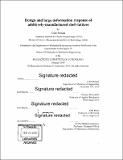Design and large deformation response of additively-manufactured shell-lattices
Author(s)
Bonatti, Colin.
Download1102057782-MIT.pdf (26.49Mb)
Other Contributors
Massachusetts Institute of Technology. Department of Mechanical Engineering.
Advisor
Tomasz Wierzbicki and Dirk Mohr.
Terms of use
Metadata
Show full item recordAbstract
Open-cell cellular solids are porous structures with a large variety of applications, from energy absorption to medical engineering. In an attempt to identify isotropic configurations with high low and large strain mechanical properties, detailed numerical simulations are conducted on a wide range of mesostructures of cubic symmetry. Results are partially validated through uniaxial compression of specimens made of 316L stainless steel via selective laser melting. In a first study the large deformation responses of four different mesostructures of relative density 20% are compared: an octet truss-lattice, tube-lattice, a sphere assembly and a tube/sphere hybrid. It is concluded that periodic shell structures provide superior strength and energy absorption capacity for the same weight, as compared to truss-lattices. Another conclusion is that to avoid concentrations of plastic strains that are detrimental to the overall energy absorption of the structure, it is best to avoid peaks in curvature. Based on these conclusions, a shell-lattice is developed that resembles a smoothened Triply Periodic Minimal Surface of FCC symmetry. Its properties are compared to those of the octet-truss for a wide range of relative densities, revealing the shell-lattice as superior to the octet-truss in almost all cases. The FCC shell-lattice is then compared to its BCC and SC equivalents. It is found that the structures all present high anisotropic properties. For a given structure, directional difference factors of up to 4.1 in uniaxial stiffness, 2 in yield strength and 1.8 in specific energy absorption are observed. However the directional averages of their properties are very similar. Irrespective of the specific type of cubic symmetry, the shell-lattices are remarkably stiff, strong and energy-specific type of cubic symmetry, the shell-lattices are remarkably stiff, strong and energy-absorbing, particularly at relative densities above 0.1. To address the problem of anisotropy, novel families of shell-lattices that contain the previous examples are proposed. Design maps are established and reveal that the elastic anisotropy of shell-lattices can be conveniently tailored. As a result, isotropic topologies are identified. The elastically-isotropic shell-lattices feature similar overall performance that their TPMS-like counterparts as well as a significantly reduced plastic anisotropy. The structures obtained are believed to be the best performing open-cell topologies to date.
Description
Thesis: Ph. D., Massachusetts Institute of Technology, Department of Mechanical Engineering, 2019 Cataloged from PDF version of thesis. Includes bibliographical references (pages 179-185).
Date issued
2019Department
Massachusetts Institute of Technology. Department of Mechanical EngineeringPublisher
Massachusetts Institute of Technology
Keywords
Mechanical Engineering.